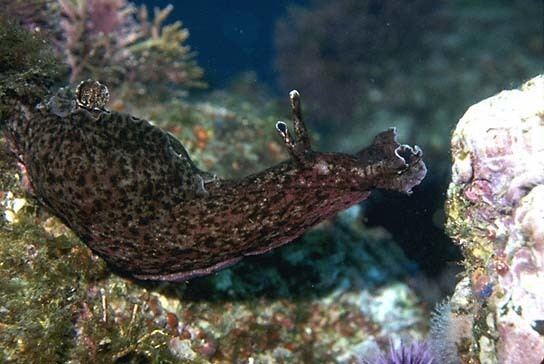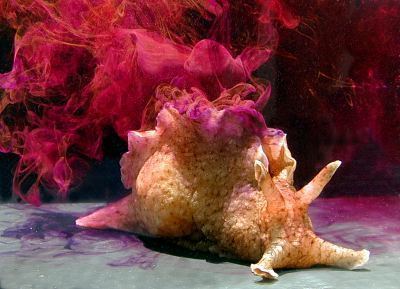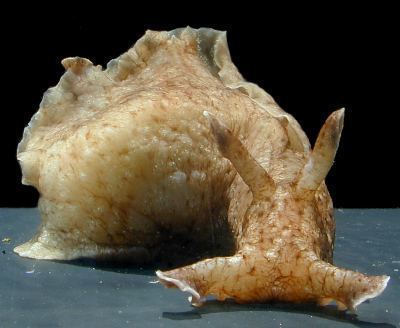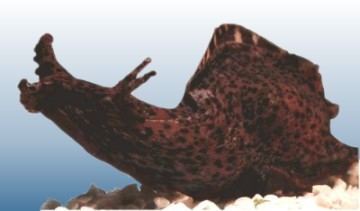Superfamily Aplysioidea Scientific name Aplysia | Higher classification Aplysiidae | |
 | ||
Lower classifications California sea hare, Aplysia punctata, Aplysia dactylomela, Aplysia fasciata, Aplysia depilans | ||
Aplysia (/əˈpliʒiːə/ or /əˈpliʒə/) is a genus of medium-sized to extremely large sea slugs, specifically sea hares, which are one clade of large sea slugs, marine gastropod mollusks. The general description of sea hares can be found in the article on the superfamily Aplysioidea.
Contents
- The california sea hare aplysia californica
- Long term memory
- Operant conditioning
- Reproduction
- Self defense
- Species
- References

These benthic herbivorous creatures can become rather large compared with most other mollusks. They graze in tidal and subtidal zones of tropical waters, mostly in the Indo-Pacific Ocean (23 species); but they can also be found in the Atlantic Ocean (12 species), with a few species occurring in the Mediterranean.

Aplysia species, when threatened, frequently release clouds of ink, it is believed in order to blind the attacker (though they are in fact considered edible by relatively few species). Following the lead of Eric R. Kandel, the genus has been studied as a model organism by neurobiologists, because its siphon-withdrawal response, as studied in Aplysia californica, is mediated by electrical synapses, which allow several neurons to fire synchronously (Kandel et al., 2000). (See : Aplysia gill and siphon withdrawal reflex) This quick neural response is necessary for a speedy reaction to danger by the animal. Aplysia has only about 20,000 neurons, making it a favorite subject for investigation by neuroscientists. Also, the 'tongue' on the underside is controlled by only two neurons, which allowed complete mapping of the innervation network to be carried out.

The california sea hare aplysia californica
Long-term memory

In neurons that mediate several forms of long-term memory in Aplysia, the DNA repair enzyme poly ADP ribose polymerase 1 (PARP-1) is activated. In virtually all eukaryotic cells tested, the addition of polyADP-ribosyl groups to proteins (polyADP-ribosylation) occurs as a response to DNA damage. Thus the finding of activation of PARP-1 during learning and its requirement for long-term memory was surprising. Cohen-Aromon et al. suggested that fast and transient decondensation of chromatin structure by polyADP-ribosylation enables the transcription needed to form long-term memory without strand-breaks in DNA. Subsequent to these findings in Aplysia, further research was done with mice and it was found that polyADP-ribosylation is also required for long-term memory formation in mammals.
Operant conditioning

Operant conditioning is considered a form of associative learning. Because operant conditioning involves intricate interaction between an action and a stimulus (in this case food) it is closely associated with the acquisition of compulsive behavior. The Aplysia species serve as an ideal model system for the physical studying of food-reward learning, due to “the neuronal components of parts of its ganglionic nervous system that are responsible for the generation of feeding movements.” As a result, Aplysia has been used in associative learning studies to derive certain aspects of feeding and operant conditioning in the context of compulsive behavior.

In Aplysia, the primary reflex studied by scientist while studying operant conditioning is the gill and siphon withdraw reflex. The gill and siphon withdraw reflex allows the Aplysia to pull back its siphon and gill into its shell. The links between the synapses during the gill and siphon withdraw reflex are directly correlated to many behavioral traits in the Aplysia such as its habits, reflexes, and conditioning. Scientist study the conditioning of the Aplysia to find correlations with the conditioning of mammals, mainly regarding behavioral responses such as addiction. Through experiments on the conditioning of the Aplysia, links have been discovered with the synaptic plasticity for reward functions involved in the trait of addiction within mammals. Synaptic plasticity is the idea that the synapses will become stronger or weaker depending on how much those specific synapses are used. Conditioning of these synapses can impact them to become stronger or weaker by causing the neurons to fire or not fire when influenced by a stimulus. The conditioning of behavioral traits is based on the idea of a reward function. A reward function is when a stimulus is conditioned to fire according to a certain stimulus. The neurons will adapt to that stimuli, and fire those neurons easier, even if the stimuli have a negative effect on the subject (in this case the Aplysia). The reward function is mainly controlled by ventral tegmental area (VTA) dopamine neurons. During conditioning, the VTA dopamine neurons have an increased effect on the stimuli being conditioned, and a decreased effect on the stimuli not being conditioned. This creates the synapses to form an expectation for reward for the stimuli being conditioned. The properties of the synapses displayed in the tests on conditioning involving the VTA dopamine neurons in the Aplysia are directly related to behavioral responses such as addiction in mammals.
Reproduction
The California sea hare, Aplysia californica, is a simultaneous hermaphrodite. A simultaneous (or synchronous) hermaphrodite is an adult organism that has both male and female sexual organs at the same time. A. californica has the ability to store and digest allosperm (sperm from a partner) and often mates with multiple partners. Studies of multiple matings in A. californica have provided insights on how conflicts between the sexes are resolved. A potent sex pheromone, the water-borne protein attractin, is employed in promoting and maintaining mating in Aplysia. Attractin interacts with three other Aplysia protein pheromones (enticin, temptin or seductin) in a binary fashion to stimulate mate attraction.
Self-defense
Aplysia species were once thought to use ink to escape from predators, much like the octopus. Instead, recent research has made it clear that these sea slugs are able to produce and secrete toxic “substances such as ammonia” in self-defense. The ability of the Aplysia species to hold toxins within their bodies without poisoning itself is a result of the unique way that the toxin is stored within the slug. Different molecules essential to the creation of the toxin are accumulated in separate parts of the body of the slug, rendering them benign, as only the mixing of all the molecules can result in a toxic chemical cloud. When the sea hare feels threatened it immediately begins the process of defending itself by mixing the distinct molecules in an additional part of the body used specifically for that purpose. At which point, enzymes within the sea slug begin the process of making the substance toxic, and the mixture is ejected out at the predator in self-defense.
Species
Species within the genus Aplysia are as follows. This list follows the studies of Medina et al. who established a phylogenetic hypothesis for the genus Aplysia through study of the partial mitochondrial DNA (mtDNA) sequence data of ribosomal genes (rDNA).
